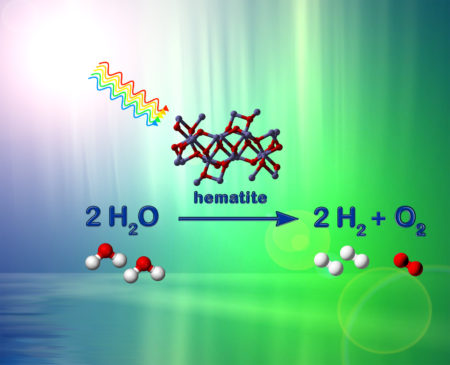Hydrogen is an attractive form of fuel because its only by-product is nonpolluting water vapor. The problem, however, is that the production of hydrogen—via the process of water splitting—currently requires the burning of traditional fossil fuels. Therefore, water splitting by photoelectrochemical cells (PECs) fueled by solar power has long been a primary goal of sustainable energy research. One roadblock to this goal is that the search for stable, affordable, high-performance PEC electrodes has so far failed to identify an ideal material. Now, researchers from Switzerland, China, and Berkeley have gained an in-depth understanding of the electronic structure of hematite (iron oxide), a promising PEC photoanode candidate, by performing in situ and operando soft x-ray spectroscopy at ALS Beamline 7.0.1.

Hematite (α-Fe2O3), the mineral form of iron oxide (i.e., rust), is an interesting PEC photoanode material because of its affordability, availability, good stability, and good spectral match to the solar spectrum. It has a relatively small band gap (2.0 eV), giving it the ability to harvest over 16% of standard solar illumination. Although the conduction band of hematite is too low to reduce water, when a dc bias is applied, such as in a tandem cell, water splitting is possible. However, the incident-photon-to-current efficiency (external quantum efficiency) of hematite is less than that of other metal oxides due to its electronic structure, which causes an ultrashort electron–hole excited-state lifetime. Because of inefficient charge separation, the photocurrent produced is limited by the holes that reach the semiconductor–liquid junction. Recent efforts to optimize the nanostructured morphologies of hematite photoanodes have led to significant improvements in performance, but in spite of these efforts, the overall solar-photon-to-photocurrent efficiency in hematite remains at only about a third of its potential.
Thus, a complete understanding of the surface electronic states of hematite has so far been the subject of much interest as well as debate. It has historically been suspected that in hematite, two different holes are formed with different water-splitting power. The existence of different types of holes with disparate reactivity toward water oxidation has broad implications for the ultimate performance of hematite. But studies of this phenomenon are complicated by the fact that the holes needed for solar-powered water splitting by hematite require an anodic electric bias in addition to optical illumination. Moreover, the holes are transitional and quite elusive.
In this work, the researchers used a specially designed soft x-ray in-situ/operando cell developed at the ALS to perform photoelectrochemical experiments with state-of-the-art silicon-doped and nanostructured hematite photoanodes in alkaline electrolyte. They recorded near-edge x-ray absorption fine-structure (NEXAFS) spectra under simulated sunlight and in the dark. Under these conditions, two new spectral signatures evolved in the valence band, which the researchers identified as an O 2p hole transition into the charge-transfer band and an Fe 3d-type hole transition into the upper Hubbard band.


Research conducted by: A. Braun [Swiss Federal Laboratories for Materials Science and Technology (Empa)]; K. Sivula and M. Grätzel (Ecole Polytechnique Federal de Lausanne, Switzerland); D.K. Bora [Swiss Federal Laboratories for Materials Science and Technology (Empa); University of Basel, Switzerland; and ALS); J. Zhu and L. Zhang (National Synchrotron Radiation Laboratory, China); E.C. Constable (University of Basel, Switzerland); and J. Guo (ALS).
Research funding: Hydrogen Program of the Swiss Federal Office of Energy, the Swiss National Science Foundation, and the European Community. Operation of the ALS is supported by the U.S. Department of Energy, Office of Basic Energy Sciences.
Publication about this research: A. Braun, K. Sivula, D.K. Bora, J. Zhu, L. Zhang, M. Grätzel, J. Guo, and E.C. Constable, “Direct Observation of Two Electron Holes in a Hematite Photo-Anode during Photoelectrochemical Water Splitting,” J. Phys. Chem. C 116, 16870 (2012).
ALS SCIENCE HIGHLIGHT #256